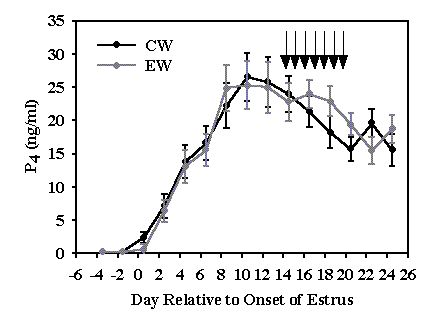
Purdue University 1999 Swine Day Report
B.A. Belstra, M.A. Diekman, W.L. Singleton, and B.T.
Richert
Department of Animal Sciences
The increasing use of early weaning technology in the U.S. has led to the progressive reduction of average lactation length (weaning age). An estimated 25% of U.S. producers utilized an average lactation length ≤ 16.2 days in a recent records database summary, and the average lactation length for all 612 farms was 18.9 days (PigCHAMP® , 1999). In addition to improving piglet health and growth rate, the short lactation lengths (≤ 17 days) necessary to derive pigs free of certain pathogens have the potential to increase sow productivity by decreasing the farrowing-to-farrowing interval and increasing the number of litters per sow per year (Dial et al., 1995; King et al., 1998).
Unfortunately, these potential benefits are sometimes nullified by a reduction in the subsequent reproductive performance of the sow (Xue et al., 1993). Short lactation lengths are associated with an increase in the length and variability of the weaning-to-estrus interval (WEI), an increased incidence of follicular cysts and anestrus, and a reduced conception rate (CR) and subsequent litter size (SLS; Svajgr et al., 1974; Marsteller et al., 1997). The reduced SLS of early weaned (EW) sows is due to increased embryo mortality and not to a reduced number of ova shed (ovulation rate) or fertilized (Varley and Cole, 1976; Hays et al., 1978; Belstra et al., 1999).
Incomplete uterine involution ("repair") is generally accepted as a contributing factor to the reduced embryo survival of EW sows, although conclusive evidence is lacking. Another mechanism hypothesized to contribute to this phenomenon is based on evidence of aberrant postweaning estradiol-17b (E2) concentrations. Varley et al. (1981, 1984) reported abnormally elevated postweaning E2 concentrations in sows weaned after a 10-day versus a 42-day lactation, and a negative relationship between E2 concentrations and embryo survival. However, other studies have not confirmed these findings (Edwards and Foxcroft, 1983; Kirkwood et al., 1984).
The conflicting evidence on the effect of short lactation lengths on postweaning steroid concentrations and the increasing number of U.S. producers practicing early weaning prompted our investigation. The primary objective of this experiment was to determine whether or not the increased embryonic mortality in EW sows is related to altered postweaning E2 or progesterone (P4) concentrations. The effect of an exogenous P4 and E2 treatment on embryo survival and endogenous concentrations of P4 and E2 was also evaluated.
Animals and Treatments: Twenty-three lactating, second parity sows (Duroc x Large White dams x Landrace sires; Newsham Hybrids) suckling an average of 8.3 ± .4 pigs were utilized. Whenever possible, litter size was standardized to 9 piglets within 2 days of farrowing. Sows had ad libitum access to water and a corn-soybean meal based lactation diet formulated to provide 1525 kcal of ME/lb, 16.0% crude protein (CP) and 0.8% lysine. Sows were randomly assigned to a 2 x 2 factorial arrangement of lactation length and injection treatments. Sows were either early weaned (EW; 13.0 ± .5 day lactation; n=12) or conventionally weaned (CW; 31.5 ± .8 day lactation; n=11).
Sows were group housed postweaning in two 12' x 32' pens, had ad libitum access to water, and were floor fed daily at 12:00 noon 5.0 lb/head of a corn-soybean meal based gestation diet formulated to provide 1483 kcal of ME/lb, 12.6% CP and 0.60% lysine. Sows were exposed to a mature boar daily at 8:00 a.m. beginning on day 3 postweaning to detect estrus, and sows that expressed estrus were artificially inseminated by the same trained technician each day they were in estrus with fresh semen from one of two fertile boars during estrus detection. Inseminated sows were moved to individual 6' x 7' pens at about day 12 postmating (day 0 = estrus onset) where they continued to receive the same ration. Sows remained in these individual pens until they were transported to the Purdue abattoir for harvest of reproductive tracts and determination of embryo survival on days 28 to 32 postmating (avg. 30.3 ± .2 days).
Crystalline progesterone (P4) and estradiol-17b (E2) were dissolved in a 15% ethyl alcohol, 15% benzyl alcohol and 70% propylene glycol mixture (vehicle) to make a solution with a concentration of 12.5 mg of P4 and 0.625 mg of E2 per mL. Sows were assigned randomly to receive a daily 2 mL intramuscular injection of this solution (25 mg P4 and 1.25 mg E2; steroid treatment, ST; n=11) or the vehicle minus the steroids as a control (control treatment, CT; n=10) from days 14 to 20 postmating inclusive. Injections were administered in the neck region as sows were fed at 12:00 noon.
Blood Sample Collection and Radioimmunoassay: Blood samples (7 to 8 mL) were collected by jugular venipuncture during a brief period of nose-snare restraint at 5 p.m. (5 hours post-injection) on alternate days from weaning until days 25 to 26 postmating. Blood samples were immediately placed on ice, transported to the laboratory, and centrifuged so that serum could be decanted and stored until analysis of P4, E2 and estrone sulfate (E1S) concentrations by radioimmunoassay.
Ovulation Rate and Embryonic Survival: Instead of exposing sows to a boar during gestation to detect estrus (pregnancy failure), transcutaneous ultrasonography was utilized at 21 to 24 days postmating to detect pregnancy. Reproductive tracts were recovered at the Purdue University abattoir, placed in viscera pans and promptly transported to the laboratory where they were weighed and placed on crushed ice. The ovaries were removed and individual corpora lutea (CL) were dissected from them to determine ovulation rate. Embryos were classified as viable based on size, color and the absence of signs of aseptic degeneration. Hemolytic amniotic fluid, placental necrosis and poor blood supply were taken as signs of degeneration and resorption. The total number of embryos (viable and nonviable) expressed as a percentage of CL (embryo rate) and the number of viable embryos expressed as a percentage of CL (embryo survival rate) were calculated to describe the proportion of ova that were recovered and that survived, respectively. A number of other reproductive tract measurements were taken that have been reported in a previous Swine Day article (Belstra et al., 1998).
Sow was the experimental unit, and only the 18 (of 21) mated sows that were pregnant at day 30 postmating were included in the statistical analysis. Data are presented as least-squares (LS) means ± standard error of the mean (SEM) in tables and figures. Early weaned sows did not exhibit an increased WEI compared to CW sows (Table 1), which may have be due to their relatively high feed intake, low body reserve loss (data not shown), small litter size (7 to 8 pigs), parity, genotype or some combination of these factors. Mabry et al. (1996) found that second parity sows could be weaned as early as 12 days and still return to estrus within 7 days and conceive effectively. While EW sows in the present study did return to estrus quickly, they may have exhibited a reduced CR. Two of the 23 original sows remained anestrus (1 EW and 1 CW sow), and of the 21 inseminated sows, 9 of 11 EW and 9 of 10 CW sows were pregnant at day 30 postmating (82 vs. 90% CR). This difference was not significant, but in an earlier report with this same genotype, we reported a 20% reduction of the CR of EW versus CW sows (71 vs. 90%; Belstra et al., 1999). Due to the limited number of sows this difference was also not significant but is in agreement with other reports (Marsteller et al., 1997). Despite their apparently lower CR, EW sows actually tended to accept more inseminations on average than CW sows (P<.09).
Ovulation rate (no. CL) was not affected by lactation length, but EW sows exhibited a decrease of 5.6 viable embryos (P<.02) and 28% decrease in embryo survival (P<.02) by day 30 postmating compared to CW sows. Despite this difference in embryo survival, lactation length had little effect on postweaning P4 or E2 concentrations (Figures 1 and 2). The seven vertical arrows in Figures 1 through 4 represent the seven days of injection treatment (CT or ST). Serum P4 concentrations did not differ at any time point between weaning treatments, and although EW sows appeared to have a greater E2 concentration on day -1.5, this difference was not significant (P>.11). Peak (maximum) E2 concentration during the preovulatory surge and the peak E2 concentration-to-estrus onset interval was not different between weaning treatments (Table 1). Both EW and CW sows had a similar interval from peak E2 concentration to P4 concentration ≥ 5 ng/mL; however, the change in P4 concentration between days 0.5 and 2.5 was negatively related to embryo survival in CW sows (r = -.84; P<.04) but not in EW sows (r = -.17; P>.60). Thus, the slightly more rapid increase in P4 concentration during the immediate postovulatory period that occurred in some CW sows (Figure 1) had a negative effect on embryo survival. There was no consistent relationship between ovulation rate and peripheral concentrations of P4 at any time point or the change in P4 concentration over time. Overall, lactation length exerted no major effects on postweaning P4 or E2 concentrations and these steroid profiles are similar to other published reports.
The lactation length, WEI and number of inseminations accepted did not differ for ST and CT sows. Steroid treated sows tended to have about 4 more viable embryos (P<.08) and 22% greater embryo survival (P<.07) compared to CT sows (Table 1). However, ovulation rate also tended to be greater for ST than CT sows (P<.06). While it is possible this difference in ovulation rate contributed to the greater number of viable embryos in ST sows, it seems somewhat unlikely, because ovulation rate was negatively correlated with embryo survival (r = -.44; P<.07) and was not correlated with the number of live embryos (r = .11; P>.60). Further, embryo survival was adjusted with ovulation rate as a covariate to avoid any bias. Therefore, the adopted ST tended to improve embryo survival and may warrant further investigation on a larger scale. Similar treatments have increased embryo/fetal survival by about 10% at day 55 postmating (Reddy et al., 1958) and litter size at term by 1 to 1.5 pigs (Wildt et al., 1976; de Sa et al., 1981). Unfortunately, the ST may induce the formation of follicular cysts in sows that are non-pregnant during treatment. Two of the 3 sows that were open were also ST, and one of these sows had developed multiple, large (0.8 to 1.6"), follicular cysts. Three additional EW-ST sows in a previous study also developed follicular cysts prior to day 30 postmating. The short lactation length (EW) may have induced cyst development during immediate postweaning follicular growth, or the small, repeated doses of P4 may have induced cyst formation in EW sows that were open and attempting to return to estrus during ST.
Serum P4 concentrations tended to be greater for ST than for CT sows on day 16.5 (P<.07) and were numerically greater on day 18.5 (Figure 3). Both of these time points are during the ST period (days 14 to 20 postmating), but this effect was not consistent across weaning treatments. When EW-ST and CW-ST sows were compared to their CT counterparts, only EW sows exhibited an increase in serum P4 concentration at day 16.5 postmating (data not shown). Further, peak P4 concentration and P4 concentrations on days 12.5, 14.5 and 16.5 were positively correlated with embryo survival in EW sows (r = .58 to .64, P<.10) but not CW sows (r = -.39 to .21, P>.30). Since ST tended to increase P4 concentrations (at least for EW sows) during a period past the point where peak P4 concentration normally occurs, the interval from estrus onset to peak P4 concentrations tended to be longer for ST than for CT sows (P<.06, Table 1). Peak P4 concentrations were not different between weaning treatments, but EW sows exhibited a 2.7 day shorter estrus onset-to-peak P4 concentration interval and peak E2 concentration-to-peak P4 concentration interval than CW sows (P<.01). These differences were unexpected, because ST increased the time to peak P4 concentrations in EW but not CW sows. However, EW-CT sows reached peak P4 concentrations much earlier than their ST counterparts (day 8.5 vs. day 16.5), which offset the later peak in P4 concentration caused by ST. We are at a loss to explain the earlier peak in P4 concentrations in EW-CT sows and the lack of an increase in P4 concentrations during ST in CW sows. The large amount of variation in steroid profile between sows and the limited number of sows sampled may explain these phenomena.
Estrone sulfate in maternal circulation is the product of embryo/placental estrogen synthesis, and E1S concentrations are proportional to the number of embryos/placentae in utero and are a good indicator of placental function and embryo viability. Early embryos (blastocysts) synthesize estrogens to signal their presence to the uterus (day 12 and days 15 to 20 of gestation) and induce changes in the uterine environment that allow attachment/implantation to occur, and to extend the life-span of the CL so that pregnancy can be maintained (maternal recognition of pregnancy). Serum E1S concentrations tended to be increased on days 18.5, 20.5, and 22.5 (P<.10), and were significantly increased on day 24.5 postmating (P<.01) in CW compared to EW sows (Figure 5). This was expected, because CW sows had 5.6 more live embryos at day 30 postmating compared to EW sows. However, E1S concentrations remained greater in CW than EW sows at day 24.5 postmating after adjustment for the total number of embryos (Figure 6). This may suggest reduced estrogen synthesis by the conceptuses of EW sows and could be related to their decreased survival rate. The change in E1S concentration from days 16.5 to 24.5 was positively correlated with embryo survival for all sows (r = .54; P<.05). This may indicate that very little embryo loss occurred after day 16, which is supported by the relatively low number of nonviable embryos recovered at day 30. Serum E1S concentrations were not greater at any time point in ST versus CT sows after adjustment for total number of embryos (P>.17).
Even though the WEI of both EW and CW sows were relatively short, a negative relationship between the length of the WEI and the level of subsequent embryo survival was observed (Table 2). This finding has been observed in numerous data sets, and sows that returned to estrus in 7 to 10 days postweaning had a reduced farrowing rate and SLS compared to sows that returned in 3 to 6 or 11 to 14 days postweaning (Wilson and Dewey, 1993; Steverink et al., 1999). A change in ovulation rate seemed to explain the negative relationship between WEI and viable embryo numbers in CW sows, but this effect was independent of ovulation rate in EW sows. Serum P4 concentrations from day 6.5 to day 12.5 postmating were greater for sows with a WEI of 3 to 4 days compared to sows with WEI of 5 and 6 to 7 days (P<.05; Figure 7). Ovulation rate did not explain these differences in postweaning P4 concentrations between sows with different WEI. Serum E2 concentrations were not different at any time point among these three WEI classes (Figure 8). Figure 8 appears to suggest a positive relationship between the length of the WEI and peak preovulatory E2 concentration, but there was little correlation between these two variables (r = .15; P>.50).
A 2-week lactation substantially decreases the embryo survival rate and may reduce the conception rate of multiparous sows compared to a 4-week lactation. This reduction of subsequent sow reproductive performance will make it difficult to meet litter size and breeding targets. Abnormal postweaning steroid concentrations do not appear to be related to the decreased embryo survival of early weaned sows. Producers should strive to manage sows to reduce the weaning-to-estrus interval, because sows that return to estrus in ≤ 5 days seem to have greater ovulation rates and/or embryo survival rates. The exogenous steroid treatment implemented may be beneficial to sow reproductive performance, and similar treatments may be developed for commercial application in the future. Additional research to develop management strategies to ameliorate the reduced reproductive performance of early weaned sows is necessary to allow producers to wean pigs early enough to block the vertical transmission of a significant number of pathogens without compromising sow productivity.
The authors gratefully acknowledge Newsham Hybrids for donating the animals and the contributions of the ASREC swine crew for husbandry of the animals; Dr. Rod Allrich for the donation of assay reagents and assistance in preparation of a steroid vehicle solution; Jason Frank, Stephanie DeCamp and Dustin Kendall for assistance with blood sample collection and reproductive tract measurements; the Purdue abattoir crew for slaughter of the animals; and Stan Haglof for technical assistance with steroid radioimmunoassays.
Belstra, B.A., J.W. Frank, D.C. Kendall, B.T. Richert, M.A. Diekman, and W.L. Singleton. 1998. Impact of lactation length and exogenous progesterone/estradiol on embryonic survival in third parity sows. Purdue 1998 Swine Day Report. p. 54-59.
Belstra, B.A., B.T. Richert, M.A. Diekman, J.W. Frank, D.C. Kendall, and W.L. Singleton. 1999. Effect of lactation length and exogenous progesterone/estradiol-17b on embryo survival in multiparous sows. J. Anim. Sci. 77(Suppl. 2):48.
de Sa, W.F., P. Pleumsamran, C.B. Morcom, and R.W. Dukelow. 1981. Exogenous steroid effects on litter size and early embryonic survival in swine. Theriogenology. 15:245-255.
Dial, G., Y. Koketsu, J.L. Xue, T. Lucia, and P. Bahnson. 1995. Optimizing breeding performance in early weaning systems: Factors affecting the reproductive response to lactation length. Recent Advances in Swine Production and Health. University of Minnesota. 5:101-112.
Edwards, S., and G. R. Foxcroft. 1983. Endocrine changes in sows weaned at two stages of lactation. J. Reprod. Fertil. 67:161-172.
Hays, V.W., J.L. Krug, G.L. Cromwell, R.H. Dutt, and D.D. Kratzer. 1978. Effect of lactation length and dietary antibiotics on reproductive performance of sows. J. Anim. Sci. 46:884-891.
King, V.L., Y. Koketsu, D. Reeves, J.L. Xue, and G.D. Dial. 1998. Management factors associated with swine breeding-herd productivity in the United States. Preventative Veterinary Medicine. 35:255-264.
Kirkwood, R.N., K.R. Lapwood, W.C. Smith, and I.L. Anderson. 1984. Plasma concentrations of LH, prolactin, oestradiol-17b and progesterone in sows weaned after lactation for 10 or 35 days. J. Reprod. Fertil. 70:95-102.
Mabry, J.W., M.S. Culbertson, and D. Reeves. 1996. Effect of lactation length on weaning-to-first-service interval, first-service farrowing rate, and subsequent litter size. Swine Health and Production. 4:185-188.
Marsteller, T.A., G.A. Armbruster, D.B. Anderson, A.J. Wuethrich, J.L. Taylor, and J.T. Symanowski. 1997. Effect of lactation length on ovulation rate and embryo survival in swine. Swine Health and Production. 5:49-56.
PigCHAMP®. 1999. Benchmarking in Swine Herds. University of Minnesota.
Reddy, V.B., D.T. Mayer, and J.F. Lasley. 1958. Hormonal modification of the intra-uterine environment in swine and its effect on embryonic viability. Univ. Missouri. Res. Bull. 667:4-31.
Steverink, D.W.B., N.M. Soede, G.J.R. Groenland, F.W. van Schie, J.P.T.M. Noordhuizen, and B. Kemp. 1999. Duration of estrus in relation to reproduction results in pigs on commercial farms. J. Anim. Sci. 77:801-809.
Svajgr, A.J., V.W. Hays, G.L. Cromwell, and R.H. Dutt. 1974. Effect of lactation duration on reproductive performance of sows. J. Anim. Sci. 38:100-105.
Varley, M.A., and D.J.A. Cole. 1976. Studies in sow reproduction: 5. The effect of lactation length of the sow on the subsequent embryonic development. Anim. Prod. 22:79-85.
Varley, M.A., T. Atkinson, and L.N. Ross. 1981. The effect of lactation length on the circulating concentrations of progesterone and oestradiol in the early weaned sow. Theriogenology. 16:179-184.
Varley, M.A., R.E. Peaker, and T. Atkinson. 1984. Effect of lactation length of the sow on plasma progesterone, oestradiol-17b and embryonic survival. Anim. Prod. 38:113-119.
Wildt, D.E., A.A. Culver, C.B. Morcom, and W.R. Dukelow. 1976. Effect of administration of progesterone and oestrogen on litter size in pigs. J. Reprod. Fertil. 48:209-211.
Wilson, M.R., and C.E. Dewey. 1993. The associations between weaning-to-estrus interval and sow efficiency. Swine Health and Production. 1:10-15.
Xue, J.L., G.D. Dial, W.E. Marsh, P.R. Davies, and H.W. Momont. 1993. Influence of lactation length on sow productivity. Livest. Prod. Sci. 34:253-265.
Table 1. LS means (± SEM) for the effect of lactation length and injection treatment on postweaning sow reproductive performance and characteristics of progesterone (P4) and estradiol-17b (E2) profiles.
|
Treatments |
|
|
|
EW (n = 9) |
CW (n = 9) |
Significancea |
|---|---|---|---|
Lactation Length, d |
13.5 ± 1.0 |
31.3 ± 1.0 |
P<.01 |
Weaning-to-Estrus Interval, d |
5.1 ± 0.4 |
4.8 ± 0.4 |
ns |
No. Inseminations |
2.2 ± 0.1 |
1.9 ± 0.1 |
P<.09 |
Ovulation Rate, no. CL |
20.6 ± 1.2 |
21.0 ± 1.3 |
ns |
Viable Embryos |
9.9 ± 1.4 |
15.5 ± 1.5 |
P<.02 |
Embryo Survival Rateb, % |
49.8 ± 6.6 |
77.8 ± 7.1 |
P<.02 |
Peak P4 Conc., ng/mL |
30.4 ± 3.7 |
34.3 ± 3.7 |
ns |
Estrus Onset to Peak P4 Conc., d |
10.6 ± 0.6 |
13.3 ± 0.6 |
P<.01 |
Peak E2 Conc., pg/mL |
24.5 ± 3.4 |
21.3 ± 3.6 |
ns |
Peak E2 Conc. to Estrus Onset, d |
1.6 ± 0.4 |
1.7 ± 0.4 |
ns |
Peak E2 to P4 Conc. ≥ 5 ng/mL, d |
4.9 ± 0.5 |
4.7 ± 0.5 |
ns |
Peak E2 to Peak P4 Conc., d |
12.2 ± 0.6 |
14.9 ± 0.6 |
P<.01 |
|
Treatments |
|
|
|
CT (n = 9) |
ST (n = 9) |
Significancea |
|---|---|---|---|
Lactation Length, d |
23.0 ± 1.0 |
21.8 ± 1.0 |
ns |
Weaning-to-Estrus Interval, d |
5.1 ± 0.4 |
4.8 ± 0.4 |
ns |
No. Inseminations |
2.1 ± 0.1 |
2.0 ± 0.1 |
ns |
Ovulation Rate, no. CL |
18.9 ± 1.2 |
22.7 ± 1.3 |
P<.06 |
Viable Embryos |
10.7 ± 1.4 |
14.7 ± 1.5 |
P<.08 |
Embryo Survival Rateb, % |
52.6 ± 7.1 |
75.0 ± 7.6 |
P<.07 |
Peak P4 Conc., ng/mL |
31.7 ± 3.7 |
33.0 ± 3.7 |
ns |
Estrus Onset to Peak P4 Conc., d |
11.0 ± 0.6 |
12.9 ± 0.6 |
P<.06 |
Peak E2 Conc., pg/mL |
23.3 ± 3.4 |
22.6 ± 3.6 |
ns |
Peak E2 Conc. to Estrus Onset, d |
2.2 ± 0.4 |
1.1 ± 0.4 |
P<.08 |
Peak E2 to P4 Conc. ≥ 5 ng/mL, d |
4.5 ± 0.5 |
5.1 ± 0.5 |
ns |
Peak E2 to Peak P4 Conc., d |
13.2 ± 0.6 |
13.9 ± 0.6 |
ns |
Table abbreviations: EW=early weaned, CW=conventionally weaned, CT=control
treated, ST=steroid treated, CL=corpora lutea.
a ns=not significant, P>.10.
b Percentage of CL represented by a viable embryo adjusted for
ovulation rate (no. CL).
Table 2. LS means (± SEM) for the effect of weaning-to-estrus interval on ovulation rate, number of viable embryos and embryo survival rate.
No. Sows |
WEI (d) |
No. CL |
Viable Embryos |
Embryo Survival (%)c |
|---|---|---|---|---|
3 CW |
3 - 4 |
26.0 ± 2.6 |
17.5 ± 3.3a |
80.1 ± 19.1a |
5 CW |
5 |
19.2 ± 1.6 |
14.4 ± 2.1a |
74.6 ± 10.6ab |
1 CW |
6 - 7 |
16.0 ± 3.6 |
13.0 ± 4.7ab |
68.7 ± 24.5ab |
2 EW |
3 - 4 |
19.0 ± 2.6 |
12.5 ± 3.3ab |
63.7 ± 16.5ab |
4 EW |
5 |
20.3 ± 1.8 |
11.5 ± 2.3ab |
57.0 ± 11.5ab |
3 EW |
6 - 7 |
22.7 ± 2.1 |
6.7 ± 2.7b |
34.0 ± 13.7b |
Table abbreviations: EW=early weaned, CW=conventionally weaned,
WEI=weaning-to-estrus interval, CL=corpora lutea.
a,b Within a column, means lacking a common superscript letter differ
(P<.10).
c Percentage of CL represented by a viable embryo adjusted for
ovulation rate (no. CL).

Figure 1. LS means (± SEM) of serum progesterone (P4) concentrations (ng/mL) relative to onset of estrus for early weaned (EW) and conventionally weaned (CW) sows.
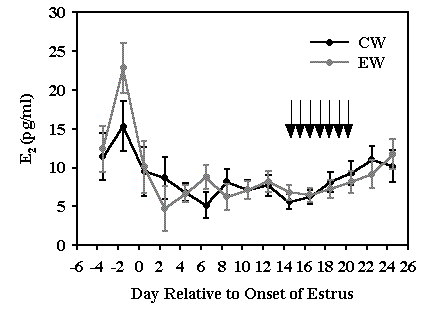
Figure 2. LS means (± SEM) of serum estradiol-17b (E2) concentrations (pg/mL) relative to onset of estrus for early weaned (EW) and conventionally weaned (CW) sows.
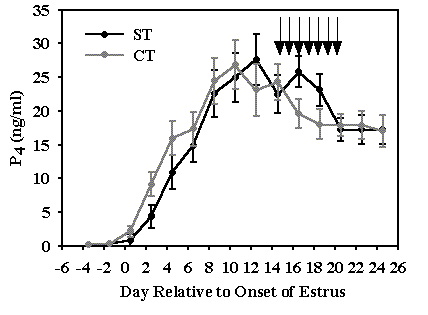
Figure 3. LS means (± SEM) of serum progesterone (P4) concentrations (ng/mL) relative to onset of estrus for control treated (CT) and steroid treated (ST) sows.
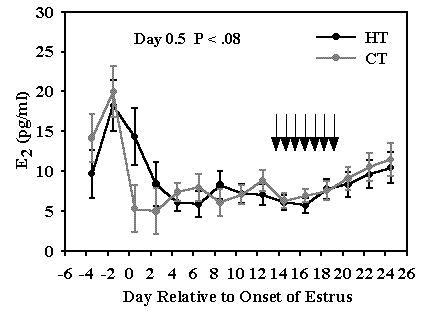
Figure 4. LS means (± SEM) of serum estradiol-17b (E2) concentrations (pg/mL) relative to onset of estrus for control treated (CT) and steroid treated (ST) sows.
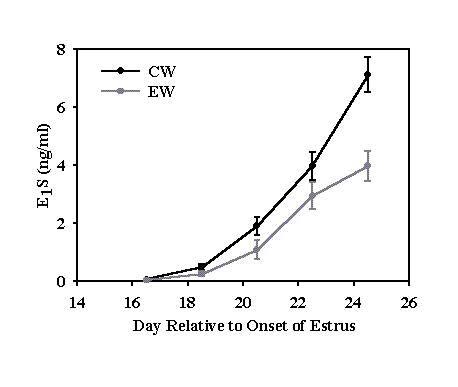
Figure 5. LS means (± SEM) of serum estrone sulfate (E1S) concentrations (ng/mL) relative to onset of estrus for early weaned (EW) and conventionally weaned (CW) sows, not adjusted for total number of embryos at day 30 postmating.
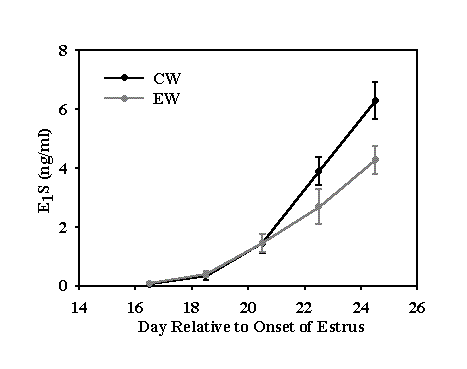
Figure 6. LS means (± SEM) of serum estrone sulfate (E1S) concentrations (ng/mL) relative to estrus onset for early weaned (EW) and conventionally weaned (CW) sows, adjusted for total number of embryos at day 30 postmating.
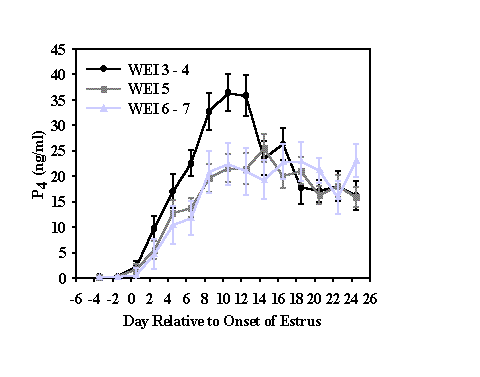
Figure 7. LS means (± SEM) of serum progesterone (P4) concentrations (ng/mL) relative to onset of estrus for sows with a weaning-to-estrus interval (WEI) of 3 to 4 days, 5 days, and 6 to 7 days.
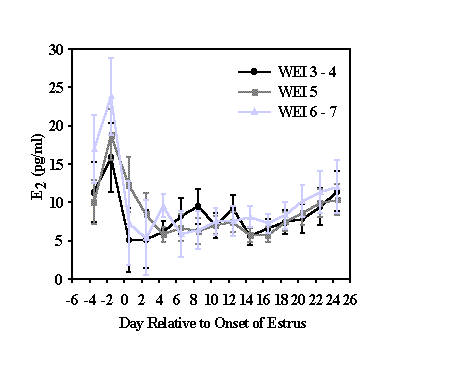
Figure 8. LS means (± SEM) of serum estradiol-17b (E2) concentrations (pg/mL) relative to estrus onset for sows with a weaning-to-estrus interval (WEI) of 3 to 4 days, 5 days, and 6 to 7 days.
Index of 1999 Purdue Swine Day Articles
If you have trouble accessing this page because of a disability, please email anscweb@purdue.edu.